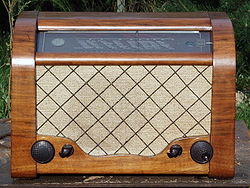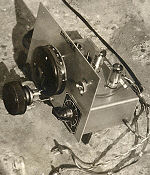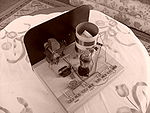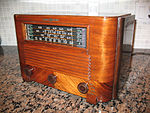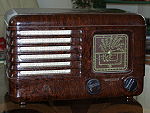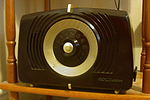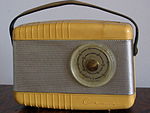- Antique radio
-
An antique radio is a radio receiving set that is collectible because of its age and rarity. Although collectors may differ on the cutoff dates, most would use 50 years old, or the pre-World War II Era, for vacuum tube sets and the first five years of transistor sets.
Contents
Types of antique radio
Morse only sets
The first radio receivers used a coherer and sounding board, and were only able to receive Morse code, and thump it out on the board. This type of transmission is called CW (Continuous wave) or wireless telegraphy. When wireless telephony (i.e. transmission & reception of speech) became possible, speech radio greatly improved the usability of radio communication. Despite this, the antiquated technology of morse code transmission continued to play an essential role in radio comms until the 1990s.
All other sections of this article concern speech capable radio, or wireless telephony.
Early home made sets
1930s style homemade one tube regenerative radio
The idea of radio as entertainment took off in 1920, and radio ownership steadily gained in popularity as the years passed. Radio sets from before 1920 are rarities.
Pre-war sets were usually made on wooden breadboards, in small cupboard style cabinets, or sometimes on an open sheet metal chassis. Homemade sets remained a strong sector of radio production until after the war. Until then there were more homemade sets in use than commercial sets.
Early sets used any of the following technologies:
- Crystal set
- Crystal set with carbon or mechanical amplifier
- Basic Tuned Radio Frequency (TRF) Sets
- TRF Reaction Sets
- Super-Regenerative Receiver
- Superheterodyne Receiver
Crystal sets
These basic radios used no battery, had no amplification and could only operate headphones. They would only receive very strong signals from a local station. They were popular among the less wealthy due to their low build cost and zero run cost. Crystal sets had minimal ability to separate stations, and where more than one high power station was present, inability to receive one without the other was a common problem.
Some crystal set users added a carbon amplifier or a mechanical turntable amplifier to give enough output to operate a speaker. Some even used a flame amplifier.
Tuned radio frequency sets
Tuned Radio Frequency sets (TRF sets) were the most popular class of early radio. These used one or more valves (tubes) to provide amplification. Early TRF sets only operated headphones, but by the 1930s it was more common to use additional amplification to power a loudspeaker, despite the expense.
The types of speakers in use at the time were crude by today's standards, and the sound quality produced from the speakers used on such sets is sometimes described as torturous. Speakers widely used on TRF sets included:
- moving iron horn speakers
- moving iron cone speakers
- tin can, magnet & wire based speakers
- in a few cases a moving coil speaker
The earliest TRF sets used no regeneration, and had very poor RF sensitivity and low selectivity. Thus only nearby stations and strong distant stations would be received, and separating different stations was not always possible.
Most TRF sets were reaction sets, also known as regenerative receivers. These rely on positive feedback to achieve adequate gain. This approach worked well enough, but is inherently unstable, and was prone to various problems. Consequently there was a significant amount of hostility over maladjusted radios transmitting squealing noises and blocking reception on nearby properties.
TRF sets had typically two tuning knobs and a reaction adjustment, all of which had to be set correctly to receive a station. Earlier reaction sets also had filament adjustment rheostats for each valve, and again settings had to be right to achieve reception.
Superheterodyne receivers
In the era of early radio, only the wealthy could afford to build a superheterodyne receiver (superhet). Such sets required many valves and numerous components, and building one was a sizeable project.
Pre-war superhets were often used with the relatively expensive moving coil speakers, which offer a quality of sound unavailable from moving iron speakers.
Most post-war commercial radios were superhets, and this technology is still in widespread use in radio receivers today, implemented with transistors or integrated circuits.
The advantages of superhets are:
- Excellent sensitivity, enabling reception of foreign broadcasts
- Complete stability
- Well controlled bandwidth
- Well shaped rf passband avoids the uncontrolled tone variations of TRF sets, and gives good selectivity
The downsides for pre-war superhets were:
- Very high build cost
- High run cost due to many valves and the need for large high power batteries
- Construction was a sizeable project
Foxhole radios
World War 2 created widespread urgent need for radio communication, and foxhole sets were built by people without access to traditional radio parts. A foxhole radio is an illegally constructed set from whatever parts one could make, which were very few indeed. Such a set typically used lighting flex for an aerial, a razor blade for a detector, and a tin can, magnet and some wire for an earpiece. I.e. they were crude crystal sets.
Wooden consoles
The console radio was the center piece of household entertainment in the era of radio, they were big and expensive running up to $700 in the late 1930s. Mostly for the wealthy, these radios were placed in hallways and living rooms.[clarification needed]Most console radios were waist high and not very wide, as the years went on they got shorter and wider. Most consumer console radios were made by RCA, Philco, General Electric, Montgomery Ward (under the Airline brand name), Sears (under the Silvertone brand name), Westinghouse, radio-bar and many more. Brands such as Zenith, Scott, Atwater-Kent, were mainly for the rich as their prices ran into the $500–$800 range in the 1930s and 1940s.
Table top wood radios
Table top radios came in many forms:
- "Cathedral style", an upright rectangular box with a rounded top
- "Tombstone style" were rectangular boxes that were tall and narrow like a tombstone
- "Table top" were rectangular, with width being the larger dimension. Table top radios were usually placed in the kitchen, sitting room or bedroom, and sometimes used out on the porch.
Bakelite
The availability of the first mass produced plastic Bakelite allowed designers much more creativity in cabinet styling, and significantly reduced costs. However, Bakelite is a brittle plastic, and dropping a radio could easily break the case. Bakelite is a brown-black mouldable thermosetting plastic, and is still used in some products today.
In the 1930s some radios were manufactured using Catalin, a colourable version of bakelite, but nearly all historic bakelite radios are the standard black-brown bakelite colour.
Plastic era
'50s transistor radio
The affordability of more modern light coloured thermoplastics in the 1950s made brighter designs practical. Some of these thermoplastics are slightly translucent.
Early transistor radios
The invention of the transistor made it possible to produce small portable radios that did not need a warm-up time, and ran on much smaller batteries. They were convenient and chic, though the prices were high and the sound quality not so good.
Transistor radios were available in many sizes from console to table-top to matchbox. Transistors are still used in today's radios, though the integrated circuit containing a large number of transistors has surpassed the use of singly packed transistors for the majority of radio circuitry.
Transistor radios appeared on the market in 1954, but at a high price. By the 1960s, reduced prices and the desire for portability made them very popular.
There was something of a marketing war over the number of transistors sets contained, with many models named after this number. Some sets even had non-functional reject transistors soldered to the circuit board, doing absolutely nothing, so the sales pitch could advertise a higher number of transistors.
Vacuum tube radios and early transistor radios were hand assembled. Today radios are designed with the assistance of computers and manufactured with much greater use of machinery.
Today's radios are usually uneconomic to repair because mass production and technological improvements in numerous areas have made them so cheap to buy, while the cost of human labour and workshop overheads have not fallen in real terms.
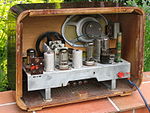 Typical insides of an antique radio, showing the vacuum tubes.
Typical insides of an antique radio, showing the vacuum tubes.
Car radios
Pre-war car radios were experimental only. They required a large aerial, reception was inconsistent, they required adjustment in use, which was not very practical. And they were of course not the most useful place to put an expensive radio.
All early car radios used a vibrator power supply to step up the low voltage to high voltage for the valves. Vibrator supplies are known for reliability problems, and produce radio interference and some mechanical noise.
Later car radios used valves that ran on twelve volts, eliminating the need for a vibrator.
The third generation of car radios were valve sets with a single output transistor, and makers were very keen to promote these as transistor sets. Some historic corn radios badged as transistorised are in reality these hybrid valve sets.
All-transistor sets eventually took over from valves as prices fell.
Warm-up time
Most valve sets needed a few seconds for the valves to heat up, though there were exceptions. Warm-up times changed as valves went through several generations of design.
- Bright emitter valves universal in the early 1920s came on in a small fraction of a second, effectively instantly.
- Direct dull emitters typical of the late '20s and 1930s came on in around a second. This type of valve continued to be popular in battery sets for several decades more.
- Indirect emitters used in more or less all mains valve radios from the late 1930s onward were slow to reach emission temperature, with wait times routinely exceeding 10 seconds.
- The last generation of valves was nuvistors. These tiny devices reached emission temperature fairly quickly.
Valuation
In terms of financial valuation:[citation needed]
- Catalin plastic radios and high end console radios sell at the top of the market.
- Cathedrals, tombstones and large table tops are midrange
- wood/bakelite table tops are in the lower mass production bracket and often sell for less than $40 each, although collectible sets (Such as the DAC90, made by Bush Radio in Britain) often sell for much more.
- The valuation of 1920s and 1930s sets depends primarily on condition and appearance. Well presented breadboard sets command a high price tag, but tatty or uninspiring samples don't. Although fairly rare, the difficulties in using such sets affect their sale value.
Use of historic radios
Post-War commercial sets
Post-war radios merely require plugging into the mains, once any faults are resolved.
Some sets have a safety issue that should be addressed, usually due to deterioration in the condition of the mains lead. Universal sets (sometimes called AC/DC sets) use a live chassis, and should be inspected carefully to ensure no screws, grub screws on knobs, or any other live metal part can be touched.
'Curtain burner' sets are an uncommon low cost type of universal set with a mains lead that warms up in use.The idea of this is to remove the need for an internal "dropper resistor." Shortening the lead or replacing it with a copper lead will damage the tube filaments by excess voltage. A fault in the radio has been known to cause the mains leads to overheat with nasty consequences, hence their popular name. Curtain burner sets are usually miniatures.
Pre-war
The minority of all-in-one commercial ac mains sets that appeared in the 1930s are plug & play. Such sets should be checked for the possible existence of live metalwork accessible to the user, and a general safety check is advisable. Many will need a repair of some sort.
However other not all-in-one types of pre-war radio are more demanding to put into service, being a long way from plug & play. Setting up such radios requires a bit of electronics skill.
There are several issues with them:
- Failed components are to be expected, and these must be fault-found then repaired
- Repair of parts is practical, but not trivial
- Some of these sets never worked very well and may benefit from some skilled debugging
- 3 power supplies are needed to replace the originally used A, B and C batteries(unless self biasing is used) (or DC mains).
- A little detective work is needed to find out what PSU voltages are needed
- A long wire antenna will need to be erected
- Fitting a local ground (earth) is frequently necessary, and quite easy
- A high impedance speaker (or transformer) is needed
- Some means to keep fingers away from the exposed live connections on the rear is wise, and often legally obligatory.
- With 1920s and earlier sets using bright emitter valves, the end user should understand the use of the filament rheostats to avoid rapid valve failure.
- The user should realise that permitting historic reaction sets to oscillate causes them to transmit interference, which is illegal.
- Negative supply DC mains sets should have their ground capacitor bypassed to convert them from live chassis to earthed chassis.
Sound quality
The sound quality of antique radios depends on the technologies used in the set. The type of speaker is the main differentiator, with mains or battery also making a significant difference.
All valve sets produce 2nd harmonic distortion, which is fairly euphonic. Some also produce significant 3rd harmonic distortion, which is less pleasant to the ear.
Discussion is often heard about the distortion of triode versus pentode valves, and single ended versus push pull, which affect the types of distortion produced, but these issues seem to be secondary in practice to the ones discussed in this article, and are already well covered in other articles.
Early sets
Moving iron speaker
Home made pre-war sets usually used some form of moving iron speaker, usually horn or cone loaded, and occasionally disc loaded. The sound quality of such radios is generally unimportant, since almost any defect in the audio signal will be masked by the butchery visited upon it by the loudspeaker. The question of sound quality is heavily dominated by the speaker in these cases. Moving iron speakers suffer the following defects:
- Gross non-linearity
- Heavy intermodulation distortion
- Little bass response
- Poor treble response
- Strong undamped resonance in the middle of the audio spectrum
- Noisy chattering when presented with a loud bass note
- Tendency of the moving iron to stick to the pole piece, resulting in a 'whack' sound followed by very little sound output.
- Gross impedance mismatch
- Need for adjustment
- Prone to demagnetisation
- Horn speakers were strongly directional
- Cone speakers were readily damaged
The sound of moving iron speakers has a strong unmistakable character.
They were far from faithful in their reproduction of audio, and their technical specifications were poorly controlled. An example of this is their electrical impedance, which varied across the audio spectrum by a ratio of more than 100:1.
It is not unusual for an electronics student, on hearing some of the specs of these devices, to conclude that they could not have been capable of reproducing speech. Yet they do, and with a sound that can not be mistaken for anything else.
Inductor dynamic speaker
These enjoyed brief success but were quickly eclipsed by moving coil speakers. The Inductor Dynamic Speaker solved the worst problems of earlier moving iron types, and provided a relatively pleasant listening experience. The main defect of ID speakers was poor treble response, giving them a charactistic dull drone.
Moving coil speaker
These speakers were mostly of sufficient quality that the radio's charactistics become significant. Transformer coupled sets suffered loss of bass & reduced treble, grid leak sets where rf and af were amplified by the same valve gave some nonlinearity, and output stages always provided a little more non-linearity. However the quality of a moving coil equipped set can be pleasant, and mistakable for a modern portable radio.
Postwar sets
Battery sets
Partial loss of bass and high frequency treble were normal, as with today's small portable radios. A small amount of non-linearity was also present.
Some sets were prone to suffering crossover distortion as the battery voltage fell. This is a rough unpleasant type of distortion. In sets prone to this, significant care was taken to avoid it, or in some cases at least minimise it.
Mains sets
Most old valve radios are in this category. Mains sets suffer the same defects as battery sets, but have a redeeming feature that gives them a characteristic warm & pleasant sound. The audio output of nearly all post-war mains valve sets is modulated by 50 & 100 Hz or 60 & 120 Hz, creating an array of extra frequencies in the audio signal. This extra content gives an impression of warmth & depth, and is easily mistaken for good bass response.
This modulation is created by a few factors working together:
- Low value smoothing capacitors cause significant 100/120 Hz ripple on the HT line.
- Significant 50/60 Hz internal wiring, ac heaters and high impedance circuitry cause injection of 50/60 Hz into all stages of the radio
- Valve non-linearity in all stages
See also
External links
- [1]
- The Antique Radio Shack- Source of high end and unusual antique radios 1920s to 1950s.
- Classic Radio Gallery - Website containing a large viewing gallery of antique radios.
- Phil's old Radios - Collection of radio ranging from the floor-standing models of the 1930s to the pocket transistor radios of the '60s.
- Antique Radios: A Collector's Resource - Website containing forum, gallery and more.
- The Philco Repair Bench - Website containing hints and information about Philco radios and more.
- The New Jersey Antique Radio Club provides an environment within which new and experienced collectors can share information regarding radio history and restoration.
- the Radio Attic - Over 1,000 antique radios for sale, with photos.
- the Radio Attic's Archives - Photos of over 8,000 unique identified radios, plus audio, amateur, and test eauipment.
- WhiteRadios.com - Antique Radio Gallery, History, and Appraisals - Website dedicated to collecting radios and perpetuating the love of the hobbie.
- Antique radio at the Open Directory Project.
Categories:
Wikimedia Foundation. 2010.

